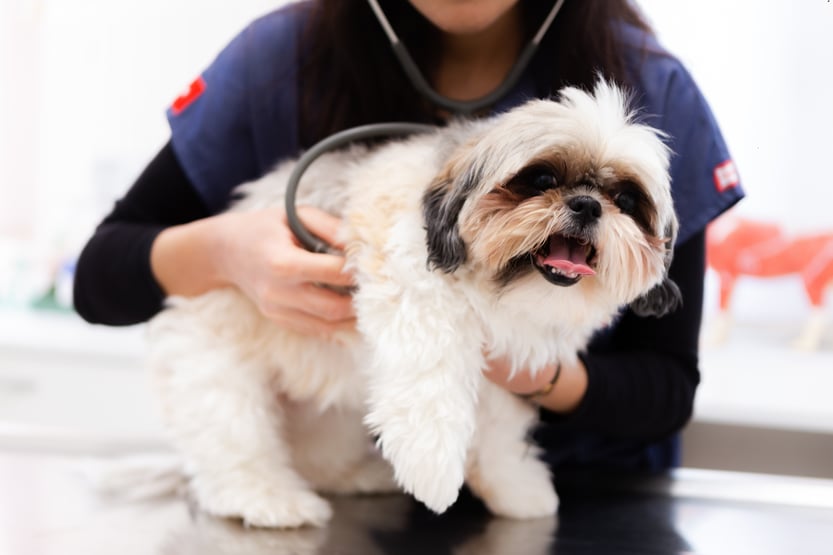Although telemedicine has been a topic of discussion in veterinary practice for years, the percentage of veterinary practices offering telehealth services increased dramatically during the Covid-19 pandemic, rising from just 12% of practices to 38% of practices by the middle of 2020.
As telemedicine becomes even more common in veterinary medicine, you may be wondering if and when you should use this modality in your practice.
What is veterinary telemedicine?
Before we talk about how to use telemedicine, let’s define it.
The American Veterinary Medical Association (AVMA) defines telemedicine as a branch of telehealth “that involves use of a tool to exchange medical information electronically from one site to another to improve a patient's clinical health status.”
On some level, you’re probably already offering telemedicine in your practice. Many phone calls between veterinarians and their existing clients fall into the category of telemedicine. A veterinarian analyzing a glucose curve provided via email is also practicing telemedicine. While these examples may not be what first comes to mind, it’s important to recognize that telemedicine can take on a variety of forms.
When to use telemedicine
Not every case can be successfully managed through telemedicine. Therefore, veterinarians offering telemedicine need to determine which cases are candidates for telemedicine and which require an in-person visit. While this decision may be made on a case-by-case basis, there are a number of guidelines to consider.
Some conditions are easily diagnosed by appearance. For example, if you see tapeworms around a cat’s rectum, you don’t need a thorough physical exam to recommend praziquantel and flea prevention. Similarly, skin lesions can often be tentatively diagnosed by appearance. Diagnostics may be needed for confirmation, but telemedicine can often help distinguish between a suspicious skin mass (warranting in-person evaluation) and a skin tag (which can be monitored and examined at the pet’s next wellness visit).
Mild injuries may also be candidates for telemedicine. For example, take the case of a dog that went for a long hike this morning and has grade 1/4 lameness this afternoon. This dog is unlikely to have a serious orthopedic condition, especially if there’s no history of lameness. A video exam would probably be adequate to prescribe a brief course of rest and NSAIDs, with the caveat that persistent or worsening signs warrant an in-person workup. You might also use photos or video to evaluate a small scab or abrasion that an owner finds on their pet, recommending a topical treatment or benign neglect.
Many veterinarians will address mild gastrointestinal signs via telemedicine in otherwise healthy pets. While a pet with severe or ongoing gastrointestinal signs needs an exam, a single episode of vomiting or diarrhea can often be addressed through telemedicine.
Finally, telemedicine can be especially valuable in follow-up care, after routine surgical procedures or treatment for illness/injury. If your practice currently recommends in-person rechecks after elective surgery, for example, could this be replaced by a video chat or an incision photograph sent by the owner? Rechecks are often good candidates for telemedicine.

Red flags: When to avoid telemedicine
Not every case is a candidate for telemedicine.
Emergencies should never be addressed through telemedicine. Veterinary emergencies include: excessive bleeding, respiratory distress, urinary obstruction, fecal obstruction, ocular injuries, toxin ingestion, neurologic abnormalities, probable fractures, extreme pain, heat stress, severe vomiting or diarrhea, and dehydration. If these conditions are a possibility, the pet needs in-person care.
Some cases require a hands-on exam to arrive at a diagnosis or rule out other conditions. While the list of conditions requiring an in-person exam is too long to list in its entirety, recommend an exam for any case involving severe or chronic lameness, abdominal discomfort, persistent or severe vomiting/diarrhea, respiratory signs, ocular disease, and/or lethargy. These conditions require palpation, auscultation, and other hands-on examination techniques.
Telemedicine is also inappropriate for conditions requiring diagnostic testing. Most moderate to severe cases of dermatitis require a skin cytology, skin scrape, and/or other diagnostics, so these cases cannot be addressed through telemedicine. Otitis externa requires an ear cytology and/or culture and sensitivity. Urinary signs require a urinalysis. In these cases, telemedicine alone is insufficient to arrive at a diagnosis or prescribe appropriate treatment.
Finally, consider technological limitations that may affect you and your clients. Telemedicine, especially via video chat, requires a camera and a high-speed internet connection for both you and your client. Your client must be in a quiet, well-lit area, and they should have the ability to move their camera so that you can see their pet well. If clients are unable to meet these criteria, an in-person visit may be the best option.
Bottom line:
Is telemedicine worth it?
Telemedicine offers advantages for both veterinary teams and pet owners. Studies show that millennials prefer telehealth, because it allows them to avoid unnecessary visits to the veterinary clinic, and clients of all ages often appreciate improved access to their veterinarian.
By decreasing barriers to care, telemedicine can improve owner compliance. Telemedicine can also improve the efficiency of the veterinary team. This is an especially important consideration these days, with many practices booked weeks in advance!
Although telemedicine will never entirely replace in-person visits, it can be a valuable adjunct to traditional veterinary care. Telemedicine provides a way for your clients to address mild concerns promptly and conveniently, instead of sweeping these issues under the rug until their pet’s next scheduled visit. Telemedicine can also provide you with a more efficient way to meet the demand for veterinary care.
By offering telemedicine (and charging appropriately for these services), you can improve your practice’s efficiency and provide a better experience for your clients.


